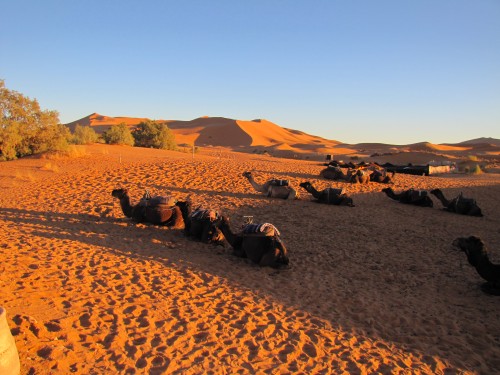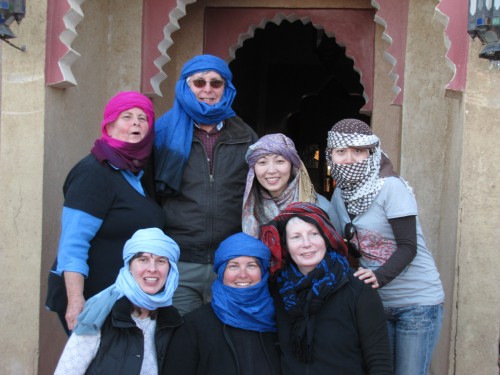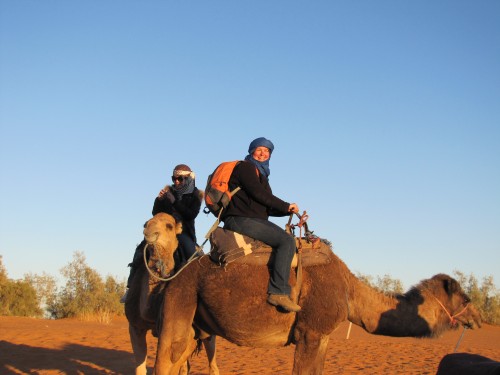Christmas Eve in the Sahara
On Christmas Day last year I wrote here about our Christmas in the the Sahara desert a few years ago. We were on a guided tour of Morocco – you can read about our adventures in recent posts (go to the Archives or use the cloud on the side bar). Our tour dates happened to bring us into the Sahara on Christmas Eve.
Once we had left our bus – including our luggage – we saw a group of camels waiting patiently to take us into the desert. I had seen the amazing colours of the Sahara in photos, but until you experience it with your own eyes at sunset, you don’t fully appreciate the depth of the colours. Some of the tour group dressed up for the occasion, including my wife and daughter (see photo below).
As we set off into the desert I realised how difficult it is to take photos while travelling on a camel. I think this was my first ever ride on a camel. The camel constantly lurches forward and then back. It is an animal which does not make a very good platform for photography. I am pleased I managed to get a few reasonable shots during the hour long journey.
In the coming days I will show more photos of this part of our journey, including our camp site in the desert.
Pondalowie Bay, Yorke Peninsula
Pondalowie Bay on the extreme south-western coast of Yorke Peninsula is favourite destination for campers, tourists and anglers. It is quite remote but the sealed road to Marion Bay and other towns further up the peninsula mean that facilities are not all that distant. Warooka is only about a hour away.
The bay has always been a popular place for people wishing to feast on the abundant fish life in the sea. In fact, although this is all part of Innes National Park, there remains a small fishing village at the bay, the small collection of beach shacks being private dwellings. A short distance back along the access road there are two camping grounds set up by national park authorities. These sites have public toilets but no other facilities, including no electric power or water.
On the day we visited recently we encountered wild gale force winds along the coast and headlands. On the other hand, the camp grounds, although windy, were quite sheltered from the worst of the gusty conditions.
Innes National Park, Yorke Peninsula
On the second day of our recent holiday on Yorke Peninsula, South Australia, we drove to the Innes National Park Visitor Centre. All visitors and campers in this national park are required to buy an entry ticket before going into the park, either from the centre staff, or from the self-serve kiosk outside.
We briefly had a look around in the centre before heading off into the park for the rest of the day.
You can find out more information about the park and the area here. This site includes links to species lists of flora and birds, as well as details of camping sites, entry fees, suggested activities and more.
Gluepot Bird Reserve part 1
Last year I travelled to a very special place. About an hour’s drive north of Waikerie in the Riverland area of South Australia is Gluepot Bird Reserve. Gluepot was once a sheep station in what is predominantly mallee country. It is called Gluepot because the various tracks through the property become like a gluepot after even a small amount of rain. Some become impassable after twenty or thirty millimetres of rain. Fortunately this amount of rain only occurs several times a year.
A few years back the property came on the market and was quickly purchased by members of Australia’s largest Birding organisation, Birds Australia. It was already known how rich the bird population was on this sheep property. It has now been established that there are more than a dozen bird species present at Gluepot that are either threatened or endangered. It is one of the few strongholds anywhere of the rare honeyeater, the Black-Eared Miner.
I had been wanting to visit Gluepot for sometime but just hadn’t got around to it. The very first course to be offered there was on developing one’s skills in nature photography. Craig Ingram was the facilitator and I enrolled hoping to learn more about using my recently purchased digital camera, the latest Canon Powershot 2S IS. The weekend was particularly good and I learned many hints on photography.
I will share more photos taken on that weekend over coming days.
Related Links:
- My photo gallery (including more shots taken at Gluepot)
Parachilna Gorge, Flinders Ranges
About 8km from the little township of Parachilna in the far north of South Australia is Parachilna Gorge. Parachilna Creek meanders through this part of the long chain of rugged mountains known as the Flinders Ranges. They were named by the English explorer Captain Matthew Flinders in 1802.
Beautiful Gorge
The creek has carved out a steep and rocky gorge through the mountains. Parachilna Gorge is one of the larger gorges in this chain of mountains. Normally the creek is a mere trickle of water easily stepped over in one stride. Several waist deep waterholes can be found in various places. In drier times, even this little trickle of water dries up. The stark red rocks of the gorge light up in the early morning or late afternoon sun and make excellent photographic subjects. The flat areas near the creek make excellent camping spots; we have camped there on a number of occasions. Many people also come here for picnics as it is a very pleasant spot to stop if travelling from other parts of the ranges.
Floods
While I was teaching at the nearby Parachilna Rural School in the late 1960s I also saw the other face of the Flinders Ranges. From my classroom I could see a long stretch of the range. Early mornings witnessed the soft blues of the hills and valleys, sometimes shrouded in mists. In the late afternoons the mountains become fiery battlements in the setting sun. Heavy rain in the ranges higher up would cause each creek to become a raging torrent of water, each emptying into the Parachilna Creek, the only way for the water to escape to the plains below. At these times the gentle trickle of water became a rampaging, runaway monster taking all before it. To see one of these creeks in flood is an awesome sight.
Flood Damage
These thundering flood waters are capable of snapping off hundred year old eucalyptus trees and sending them tumbling downstream, tossing them around like toys in a bathtub. Large boulders can be moved downstream. In one famous downpour in 1955 a section of a railway bridge south of Parachilna at Hookina was washed away by floodwaters. On at least one occasion I camped overnight in the back of my car in Parachilna Gorge waiting for the waters to subside enough to complete the drive back to Parachilna.












